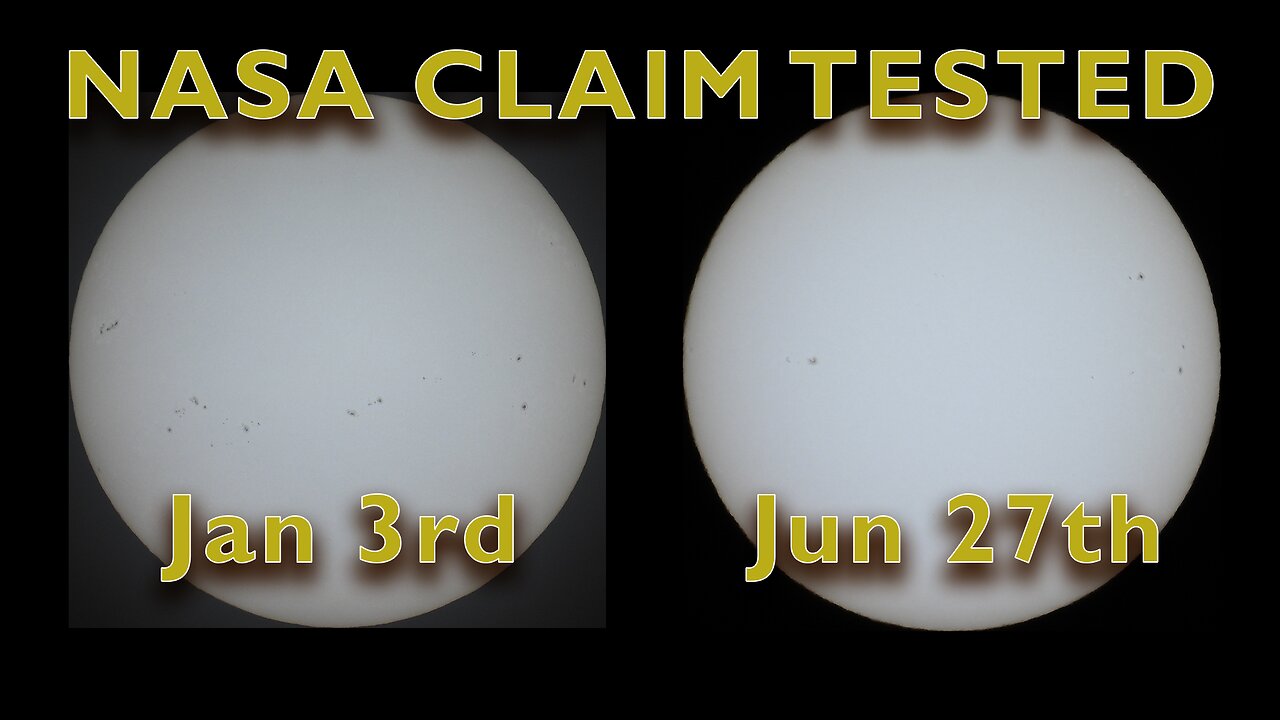Premium Only Content

I Measured the Sun’s Size to Test NASA’s Orbit Claim — Here’s What Happened
TL;DR: I tested NASA's claim that Earth’s distance from the Sun changes throughout the year by taking two photos—one in January and one in June—and measuring the Sun’s apparent size. Here's the full breakdown with all the data, equipment, and pixel math.
NASA says Earth orbits the Sun in an elliptical path, not a perfect circle. That means the distance between Earth and the Sun varies throughout the year — from about 91.4 million miles (147.1 million km) in January (perihelion) to 94.5 million miles (152.1 million km) in July (aphelion).
That distance change should cause the Sun to appear about 3.39% smaller in July than in January.
So... I tested it myself.
📸 I took two solar photos with the Nikon P950, both near solar noon:
January 3, 2025 (just before perihelion): 2,520 pixels tall
June 27, 2025 (just before aphelion): 2,429 pixels tall
Measured size change: 3.61%
That result is shockingly close to NASA's prediction — all from a camera, a solar filter, and a bit of spreadsheet math.
No tricks. No CGI. No NASA involvement. Just observation and repeatable results. This completely debunks the flat Earth claim that “the Sun always appears the same size.”
📁 I’ve included:
EXIF data from both photos
Camera and exposure settings
Step-by-step math using Excel
Commentary on pixel alignment accuracy and margins of error
Visual overlays and original image sizes
🔍 Want the raw files? Message me. I’ll send you everything, especially if you’re trying to prove me wrong.
📣 Drop your questions in the comments — or better yet, try it yourself and share what you find.
🧠 Remember:
Test the claim. See for yourself.
Subscribe for more science-based experiments, observational debunks, and hands-on testing.
-
 LIVE
LIVE
Owen Shroyer
1 hour agoOwen Report - 10-17-2025 - President Trump And Zelensky Take Questions At The White House
1,241 watching -
![[Ep 772] No Kings for Weak Minds: Funding & Following | CA Homelessness: Crisis & Scandal](https://1a-1791.com/video/fww1/d8/s8/1/g/j/B/r/gjBrz.0kob-small-Ep-772-No-Kings-for-Weak-Mi.jpg) LIVE
LIVE
The Nunn Report - w/ Dan Nunn
1 hour ago[Ep 772] No Kings for Weak Minds: Funding & Following | CA Homelessness: Crisis & Scandal
172 watching -
 1:18:31
1:18:31
The Culture War with Tim Pool
4 hours agoTim Pool Vs. Liquid Death CEO DEBATE
91.2K113 -
 LIVE
LIVE
Times Now World
18 days agoLIVE Jeffrey Sachs | Netanyahu Turned U.S. Military Into His Own War Machine | Times Now World
36 watching -
 LIVE
LIVE
ahdedazs
50 minutes agoARC Raiders Playtest! *Multistreaming*
11 watching -
 1:58:33
1:58:33
The Quartering
3 hours agoCrowder Roasts Entitled Black Man, Hasan Piker Meltdown, Leftoid Instant Regret!
25K34 -
 1:03:29
1:03:29
DeVory Darkins
4 hours ago $30.29 earnedKash Patel drops DEVASTATING NEWS for Democrats as ANTIFA suffers MAJOR LEGAL BLOW
80.2K105 -
 59:37
59:37
Jeff Ahern
2 hours agoFriday Freak out with Jeff Ahern
3.33K2 -
 1:14:56
1:14:56
Lara Logan
14 hours agoTHE ONLYFANS SCAM: Victoria Sinis Breaks Down the Dangers and Lies Targeting Your Children | EP 40
47.4K8 -
 3:02:51
3:02:51
Tundra Tactical
22 hours ago $0.28 earned{LIVE NOW} GunTuber Plays Battlefield 6...Terribly
17.6K3